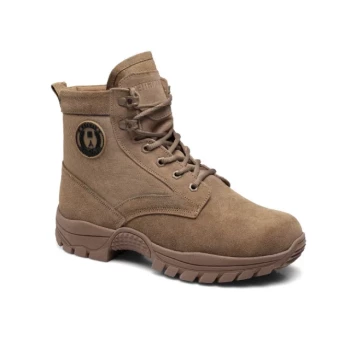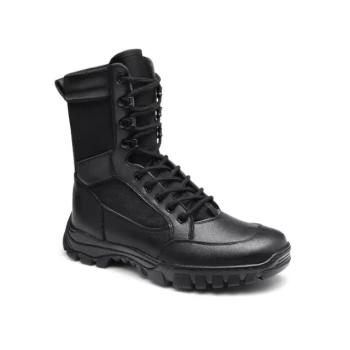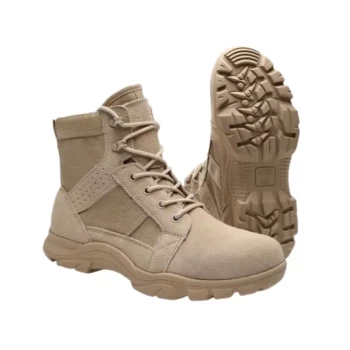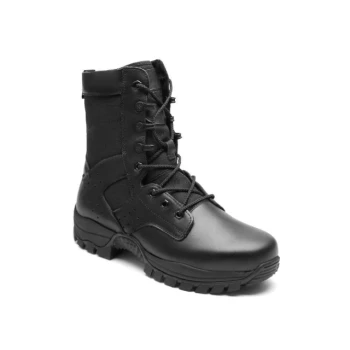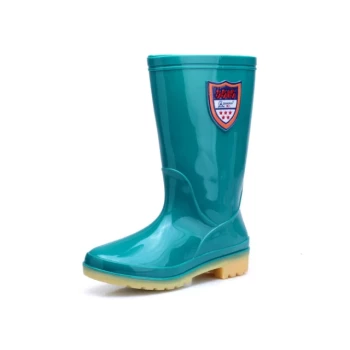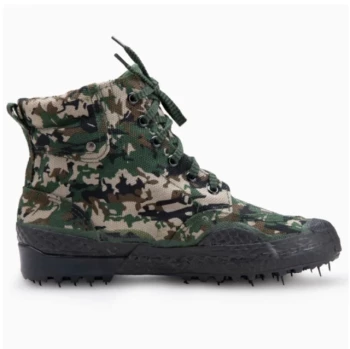Yes, but with a critical caveat. Jungle boots provide a functional level of ankle support primarily through their high-laced design, which is why they have been used in demanding military applications. However, they were specifically engineered to prioritize drainage and breathability in hot, wet climates, which means they intentionally sacrifice the rigid, reinforced structure found in boots designed for maximum support.
The core issue isn't whether jungle boots have ankle support, but understanding the trade-off they represent. They exchange the heavy, rigid support of modern hiking or tactical boots for a lighter, faster-drying design essential for jungle warfare.
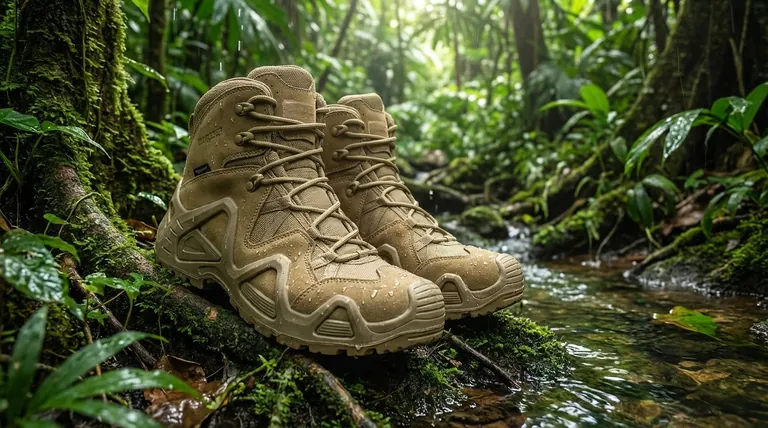
The Design Philosophy of a Jungle Boot
The original purpose of a jungle boot dictates its features. It was built to survive and function in constantly wet, hot, and humid environments.
Prioritizing Water Drainage and Breathability
The most iconic features of a jungle boot are its canvas (or nylon) upper panels and screened drainage vents near the instep.
This design is not meant to keep water out. It's designed to let water in and then drain out as quickly as possible, allowing the boot and the foot to dry while on the move.
A Compromise on Material Rigidity
Heavy, thick leather and waterproof membranes—common in modern hiking boots—would become waterlogged, heavy, and cause foot rot in a jungle environment.
Jungle boots use a leather lower and a fabric upper. This fabric provides less structural rigidity and lateral support compared to an all-leather boot.
Deconstructing "Ankle Support"
"Ankle support" is not a single feature but the result of several design elements working together. Understanding these helps clarify what a jungle boot does and does not offer.
Shaft Height
Jungle boots typically have a high shaft, lacing up 8 to 10 inches.
This height is the primary source of their support. Lacing the boot snugly around the ankle and lower calf provides a significant brace against twists and sprains on uneven ground.
Structural Stability
This refers to the boot's resistance to flexing and twisting. It comes from features like a rigid heel counter, a stiff sole, and reinforced materials in the upper.
Jungle boots are relatively flexible and have a more basic construction. They lack the robust internal shanks and reinforced heel counters common in heavy-duty work or backpacking boots.
A Snug and Secure Fit
A proper lacing system allows the boot to be tightened securely, minimizing foot movement inside the boot. This is crucial for preventing blisters and providing a stable platform.
Jungle boots feature a simple but effective eyelet or speed-lacing system that accomplishes this core function well.
Understanding the Trade-offs: Jungle Boots vs. Specialized Footwear
The level of ankle support in a jungle boot is best understood by comparing it to footwear designed for different purposes.
vs. Modern Hiking Boots
Modern hiking boots are built to protect the foot while carrying heavy loads over technical terrain. They use stiff soles, cushioned midsoles, and rigid uppers to create a highly stable platform.
A jungle boot is far more flexible and offers less protection from sharp rocks underfoot and less lateral ankle support.
vs. Paratrooper "Jump" Boots
While paratroopers have used jungle boots, a dedicated jump boot is a different tool. Jump boots are built with significantly more reinforcement in the ankle and heel.
This extra structure is designed specifically to absorb the extreme impact of a parachute landing and prevent injury, a task for which a standard jungle boot is not optimized.
vs. Work & Tactical Boots
Modern work and tactical boots often incorporate advanced materials and safety features like composite shanks, reinforced toe boxes, and external heel counters.
These features provide superior protection and stability for high-impact activities or hazardous environments, far exceeding the support offered by the classic jungle boot design.
Making the Right Choice for Your Goal
Whether a jungle boot offers "enough" support depends entirely on your intended activity and environment.
- If your primary focus is performance in a hot, wet climate: The jungle boot's design is exceptional, as its breathability and drainage will keep your feet healthier than a waterproof boot.
- If your primary focus is carrying heavy loads over rocky terrain: A dedicated hiking boot with a stiffer sole and more robust ankle structure is a much safer choice.
- If your primary focus is maximum stability for high-impact activities: You should choose a modern tactical or jump boot designed specifically for that purpose.
- If your primary focus is a lightweight, general-purpose boot: The jungle boot is a viable option, as long as you understand its structural limitations compared to more modern designs.
Ultimately, choosing the right footwear means matching the tool to the specific demands of the job.
Summary Table:
| Feature | Jungle Boots | Modern Hiking Boots |
|---|---|---|
| Primary Focus | Drainage & breathability in wet climates | Load support & stability on rough terrain |
| Ankle Support Level | Moderate (from high shaft & lacing) | High (rigid structure, reinforced heel) |
| Material Rigidity | Flexible (canvas/leather mix) | Stiff (full-grain leather, shanks) |
| Best For | Hot, humid, frequently wet conditions | Heavy loads, technical trails, rocky surfaces |
Need Footwear for Your Specific Environment?
As a large-scale manufacturer, 3515 produces a comprehensive range of footwear for distributors, brand owners, and bulk clients. Whether you need the specialized drainage of a jungle boot, the rugged support of a hiking boot, or a custom solution for your market, we have the production capabilities to meet your demand.
Contact us today to discuss your footwear needs and leverage our expertise in manufacturing all types of shoes and boots.
Visual Guide
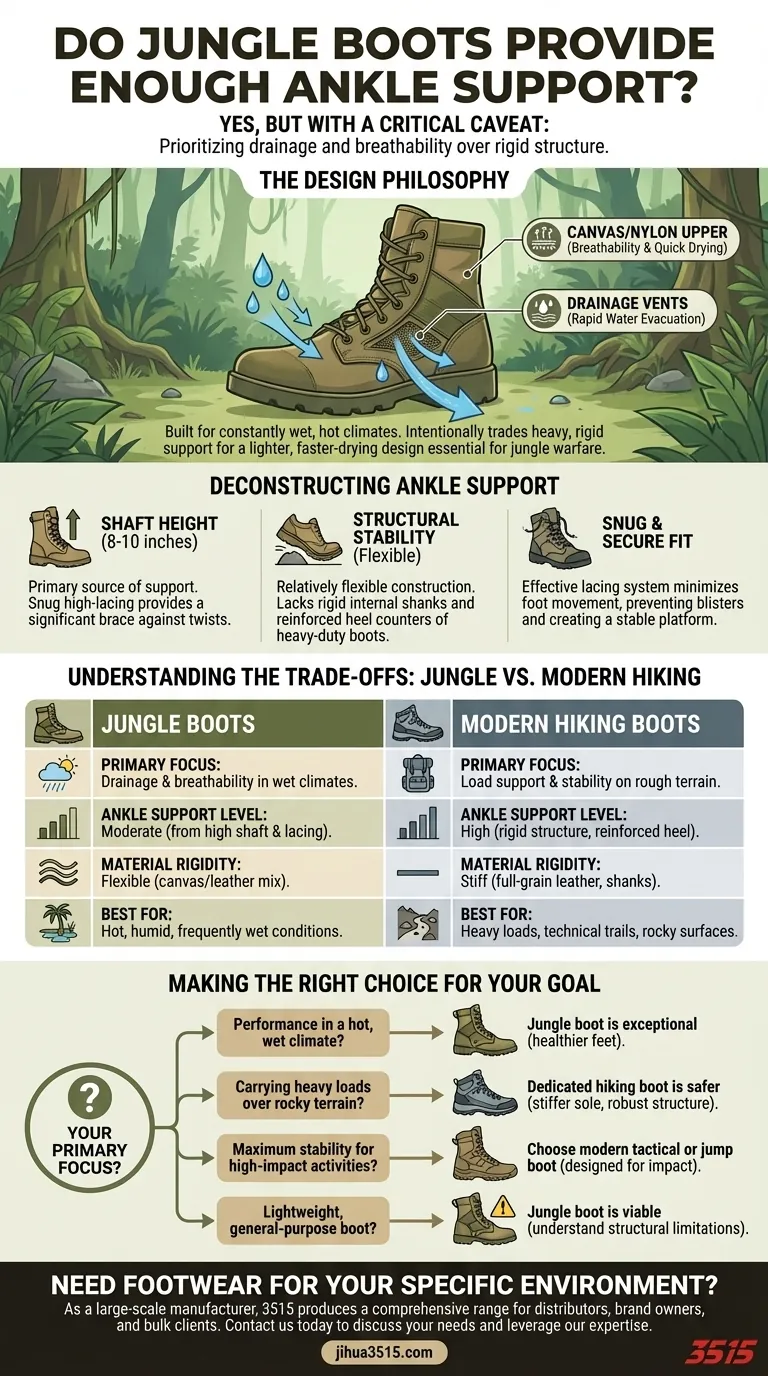
Related Products
- Wholesale Waterproof Tactical Boots Custom Suede & High-Traction Soles
- Safety Footwear Wholesale Manufacturer for Custom OEM/ODM Production
- Premium Wholesale Waterproof Safety Boots High Performance Protection for Industrial Markets
- High-Traction Suede Tactical Boots Wholesale & Custom Manufacturing
- Durable High-Ankle Tactical Boots Wholesale Manufacturer for Custom & Bulk Orders
People Also Ask
- What waterproof technology is used in tactical boots? Unlock All-Weather Performance & Protection
- What are the advantages and disadvantages of waterproof tactical boots? A Guide to the Key Trade-Offs
- Why is waterproofing important in tactical boots? Essential for Foot Health & Mission Success
- What are some real-world applications of military camouflage boots? From Tactical to Trendsetting
- What is the significance of waterproof functionality in tactical boots? Essential for Health & Performance



